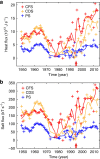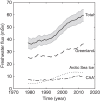Recent increases in Arctic freshwater flux affects Labrador Sea convection and Atlantic overturning circulation
- PMID: 26796579
- PMCID: PMC4736158
- DOI: 10.1038/ncomms10525
Recent increases in Arctic freshwater flux affects Labrador Sea convection and Atlantic overturning circulation
Erratum in
-
Corrigendum: Recent increases in Arctic freshwater flux affects Labrador Sea convection and Atlantic overturning circulation.Nat Commun. 2016 Nov 17;7:13545. doi: 10.1038/ncomms13545. Nat Commun. 2016. PMID: 27853146 Free PMC article. No abstract available.
Abstract
The Atlantic Meridional Overturning Circulation (AMOC) is an important component of ocean thermohaline circulation. Melting of Greenland's ice sheet is freshening the North Atlantic; however, whether the augmented freshwater flux is disrupting the AMOC is unclear. Dense Labrador Sea Water (LSW), formed by winter cooling of saline North Atlantic water and subsequent convection, is a key component of the deep southward return flow of the AMOC. Although LSW formation recently decreased, it also reached historically high values in the mid-1990s, making the connection to the freshwater flux unclear. Here we derive a new estimate of the recent freshwater flux from Greenland using updated GRACE satellite data, present new flux estimates for heat and salt from the North Atlantic into the Labrador Sea and explain recent variations in LSW formation. We suggest that changes in LSW can be directly linked to recent freshening, and suggest a possible link to AMOC weakening.
Figures





References
-
- Stommel H. Thermohaline convection with two stable regimes of flow. Tellus 13, 224–230 (1961).
-
- Rooth C. Hydrology and ocean circulation. Prog. Oceanogr. 11, 131–149 (1982).
-
- Broecker W. S., Peteet D. M. & Rind D. Does the ocean-atmosphere system have more than one stable mode of operation. Nature 315, 21–26 (1985).
-
- Broecker W. S. Unpleasant surprises in the greenhouse? Nature 328, 123–126 (1987).
-
- Wood R. A., Keen A. B., Mitchell J. F. B. & Gregory J. M. Changing spatial structure of the thermohaline circulation in response to atmospheric CO2 forcing in a climate model. Nature 401, 508–508 (1999).
Publication types
LinkOut - more resources
Full Text Sources
Other Literature Sources

